Database System Basic - 3
Database Storage II
Page Base Storage
A. Disk-oriented Architecture
The DBMS assumes that the primary storage location of the database is on non-volatile disk.
The DBMS's components manage the movement of data between non-volatile and volatile storage.
B. Log-structured File Organization
Instead of storing tuples in pages, the DBMS only stores log records
1. Update / Write Log
The system appends log records to the file of how the database was modified:
--> Inserts store the entire tuple
--> Deletes mark the tuple as deleted
--> Updates contain the delta of just the attributes that were modified
For example:
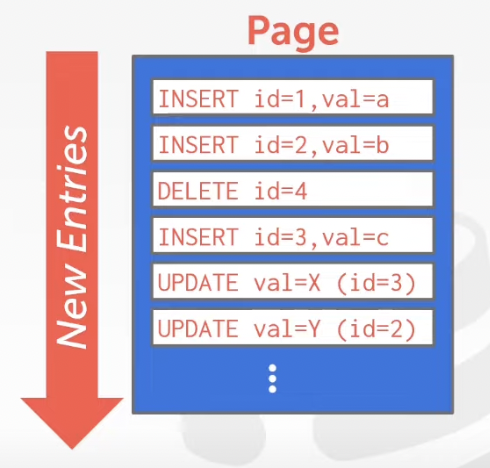
2. Read
a) To read a record, the DBMS scans the log backwards and "recreates" the tuple to find what it needs
For example:

b) Build index to allow it to jump to location in the log
For example:
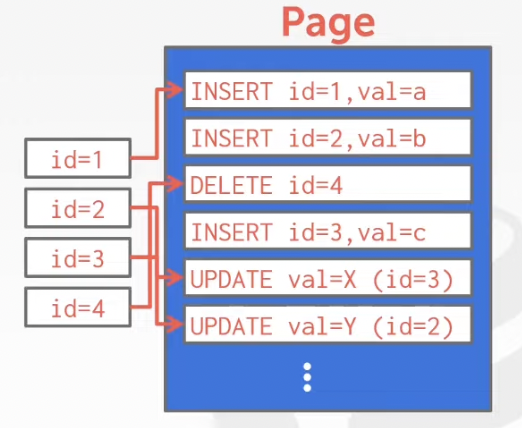
c) Periodically compact the log
For example:
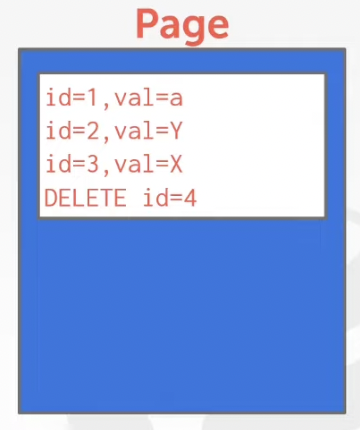
C. Log-structured Compaction
Compaction coalesces larger log files into smaller files by removing unnecessary records
| Level Compaction | Universal Compaction |
|---|---|
 | 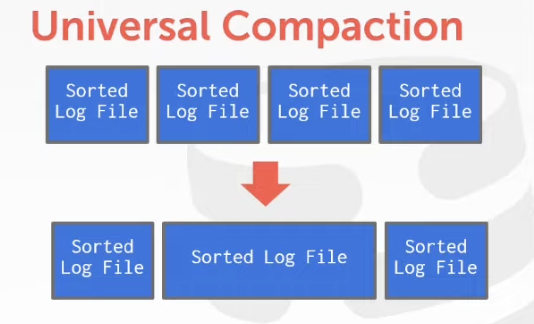 |
Data Resentation
INTEGER / BIGINT / SMALLINT / TINYINT
--> C / C++ Representation
FLOAR / REAL vs. NUMERIC / DECIMAL
--> IEEE-754 Standard / Fixed-point Decimals
VARCHAR / VARBINARY / TEXT / BLOB
--> Header with length, followed by data bytes
TIME / DATE / TIMESTAMP
--> 32 / 64-bit integer of (micro) seconds since Unix epoch
A. Variable Precision Numbers
Inexact, variable-precision numeric type that uses the "native" C / C++ types
--> Ex: FLOAT / REAL / DOUBLE
Example:
xxxxxxxxxxint main(int argc, char* argv[]) { float x = 0.1; float y = 0.2; printf("x + y = %f\n", x + y); printf("0.3 = %f\n", 0.3);}// output: // x + y = 0.300000// 0.3 = 0.300000xxxxxxxxxxint main(int argc, char* argv[]) { float x = 0.1; float y = 0.2; printf("x + y = %.20f\n", x + y); printf("0.3 = %.20f\n", 0.3);}// output: // x + y = 0.30000001192092895508// 0.3 = 0.29999999999999998890
B. Fixed Precision Numbers
Numeric data types with arbitrary precision and scale. Used when rounding errors are unacceptable
--> Ex. NUMERIC / DECIMAL
Many different implementations
1. Postgres: Numeric
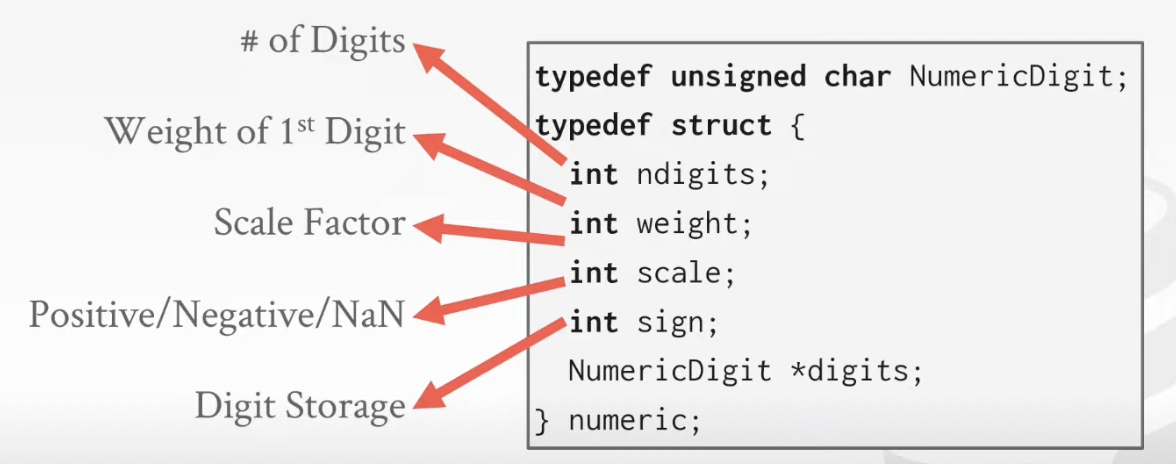
2. MySQL: Numeric
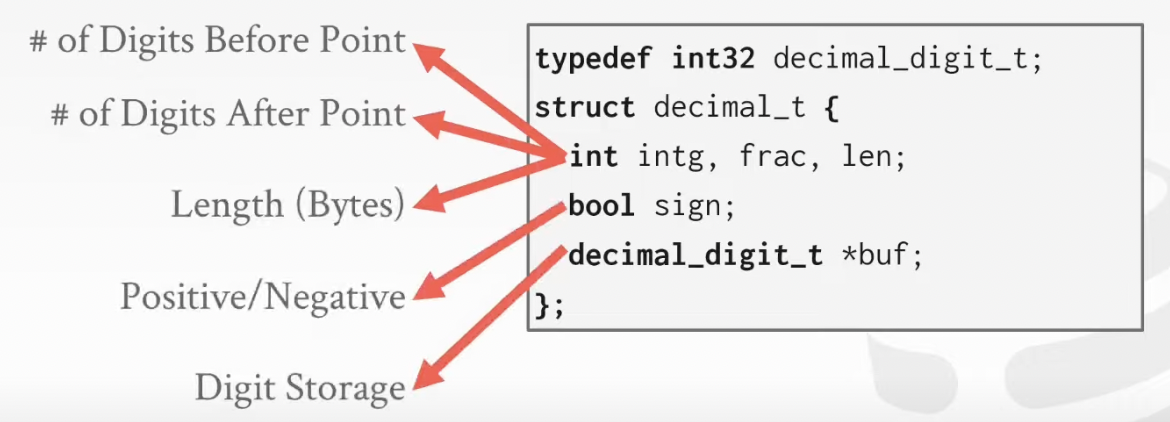
C. Large Values
Most DBMSs don't allow a tuple to exceed the size of a single page.
To store values that are larger than a page, the DBMS uses separate overflow storage pages.
--> Postgres: TOAST (> 2 KB)
--> MySQL: Overflow (> 1/2 size of page)
--> SQL Server: Overflow (> size of page)
Example:
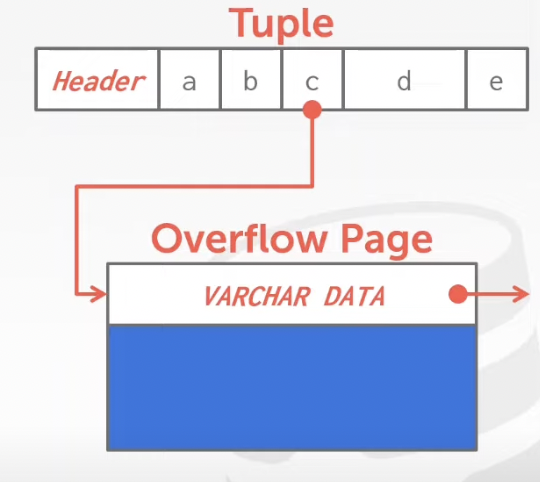
D. External Value Storage
Some systems allow you to store a really large value in an external file. Treated as a BLOB type. (Oracle & Microsoft)
The DBMS cannot manipulate the contents of an external file
Example:
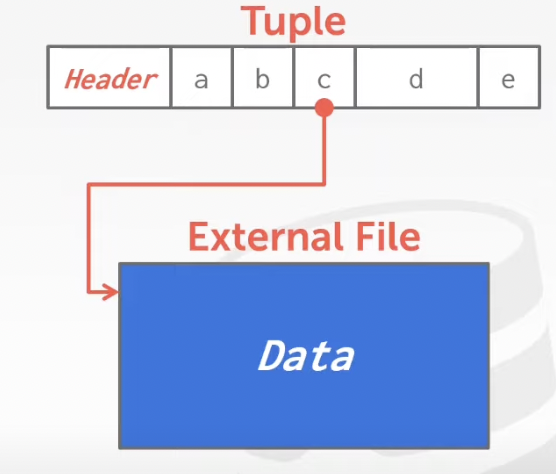
System Catalogs
A DBMS store meta-data about databases in its internal catalogs
--> Tables, columns, indexes, views
--> Users, permissions
--> Internal statistics
Almost every DBMS stores the database's catalog inside itself
--> Wrap object abstractuon around tuples
You can query the DBMS's internal INFORMATION_SCHEMA catalog to get info about the database
--> ANSI standard set of read-only views that provide info about all the tables, views, columns, and procedures in a database
A. Accessing Table Schema
For example:
SQL-92:
x
SELECT * FROM INFORMATION_SCHEMA.TABLES WHERE table_name = 'student';Postgres:
xxxxxxxxxx\d student;MySQL:
xxxxxxxxxxDESCRIBE student;SQLite:
xxxxxxxxxx.schema student
B. Database Workloads
1. On-line Transaction Processing (OLTP)
--> Fast operations that only read / update a small amount of data each time
2. On-line Analytical Processing (OLAP)
--> Complex queries that read a lot of data to compute aggregates
3. Hybrid Transaction + Analytical Processing
--> OLTP + OLAP together on the same database instance
Graph:
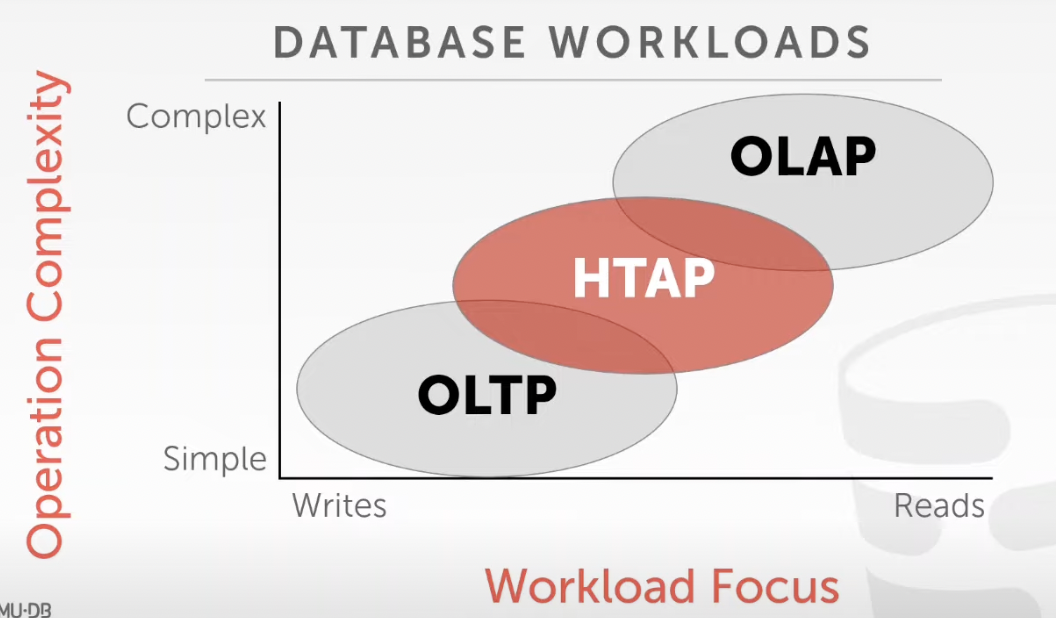
1. Bifurcated Environment
1. OLTP ----> OLAP
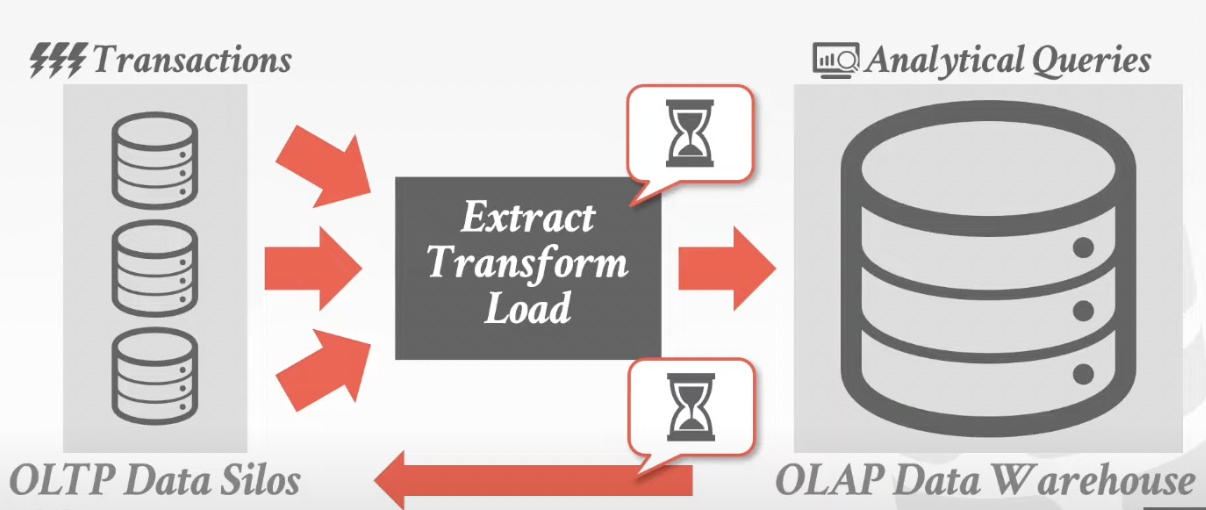
2.HTAP ----> OLAP
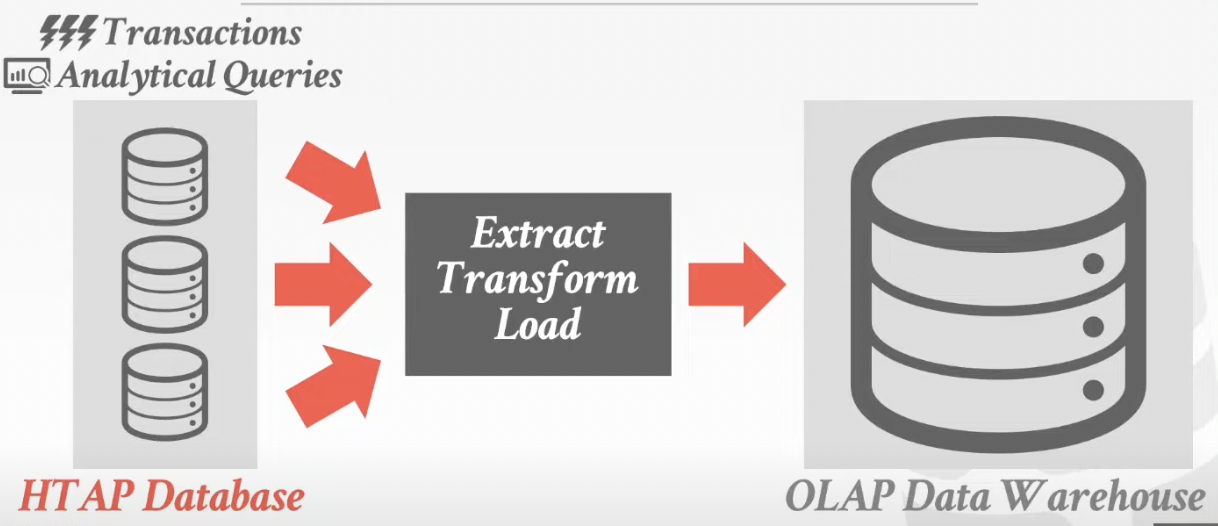
2. Wikipedia Example
x
CREATE TABLE useracct ( userID INT PRIMARY KEY, userName VARCHAR UNIQUE, ...);x
CREATE TABLE pages ( pageID INT PRIMARY KEY, title VARCHAR UNIQUE, latest INT REFERENCES revisions (revID),);xxxxxxxxxxCREATE TABLE revisions ( revID INT PRIMARY KEY, userID INT REFERENCES useracct (userID), pageID INT REFERENCES pages (pageID), content TEXT, updated DATATIME);
3. OLTP
On-line Transaction Processing (OLTP)
---> Simple queries that read / update a small amount of data that is related to a single entity in the database
xxxxxxxxxxSELECT P.*, R.* FROM pages AS P INNER JOIN revisions AS P ON P.latest = R.revID WHERE P.pageID = ?xxxxxxxxxxUPDATE useracct SET lastLogin = NOW(), hostname = ? WHERE userID = ?xxxxxxxxxxINSERT INTO revisionsVALUES (?, ?..., ?)
4. OLAP
On-line Analytical Processing (OLAP)
--> Complex queries that read large portions of the database spanning multiple entites
xxxxxxxxxxSELECT COUNT(U.lastLogin), EXTRACT(month FROM U.lastLogin) AS month FROM useracct AS U WHERE U.hostname LIKE '%.gov' GROUP BY EXTRACT(month FROM U.lastLogin)
Data Storage Models
The DBMS can store tuples in different ways that are better for either OLTP or OLAP workloads
A. N-Ary Storage Model (NSM)
The DBMS stores all attributes for a single tuple contiguously in a page
Ideal for OLTP workload where queries tend to operate only on an individual entity and insertheavy workloads
The DBMS stores all attributes for a single tuple contiguosly in a page
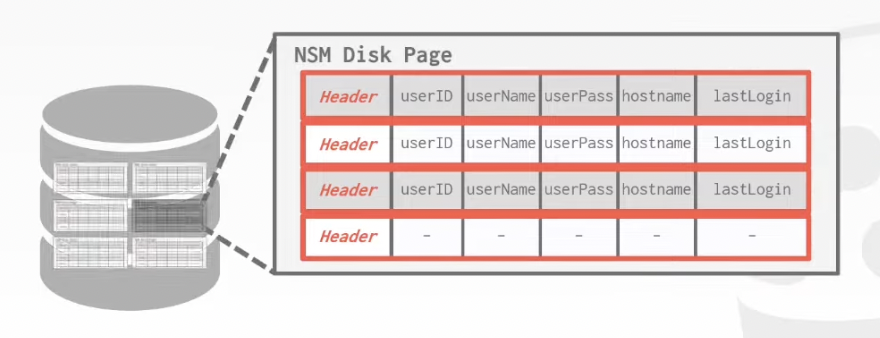
Example:


| Advantages | Disadvantages |
|---|---|
| - Fast inserts, updates, and deletes | - Not good for scanning large portions of the table and / or a subsetof the attributes |
| - Good for queries that need the entire tuple |
B. Decomposition Storage Model (DSM)
The DBMS stores the values of a single attribute for all tuples contiguously in a page
Ideal for OLAP workload where read-only queries perform large scans over a subset of the table's attributes
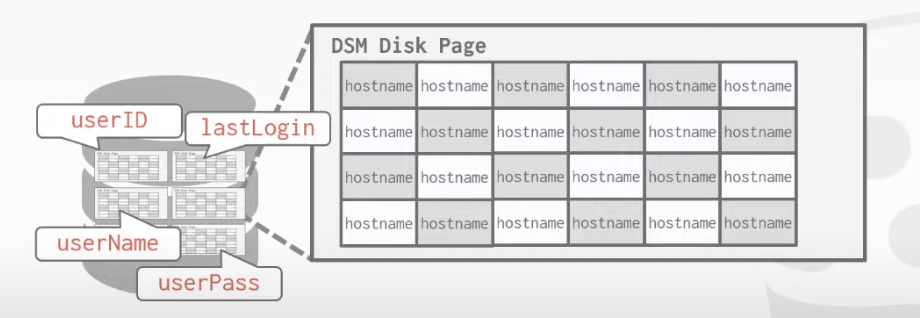
1. Example:
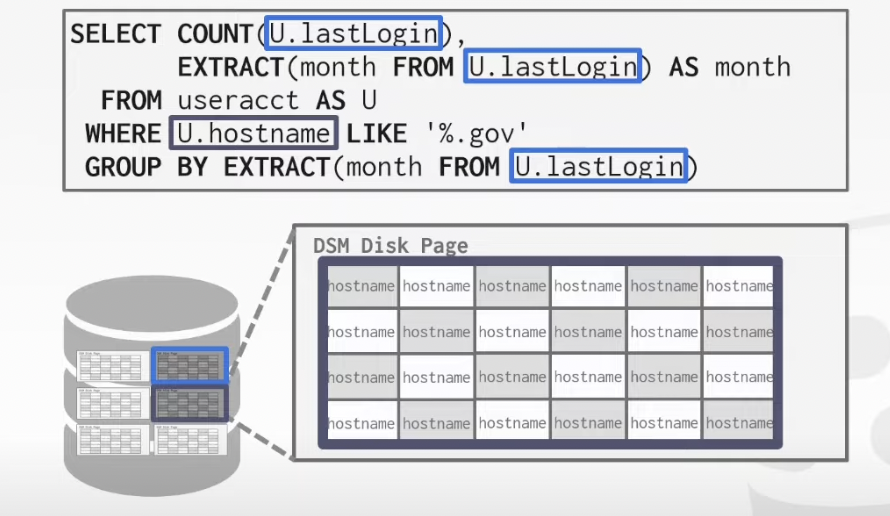
2. Tuple Identification
Choice #1: Fixed-length Offsets
--> Each value is the same length for an attribute

Choice #2: Embedded Tuple Ids
--> Each value is stored with its tuple id in a column
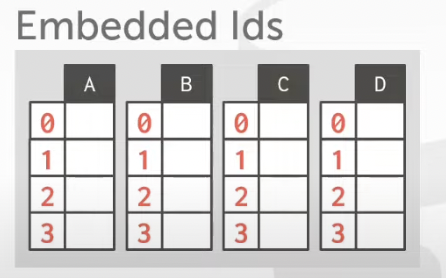
3. Advantages vs. Disadvantages
| Advantages | Disadvantages |
|---|---|
| - Reduces the amount wasted I / O because the DBMS only reads the data that it needs | - Slow for point queries, inserts, updates, and deletes because of tuple splitting / stitching |
| - Better query processing and data compression |